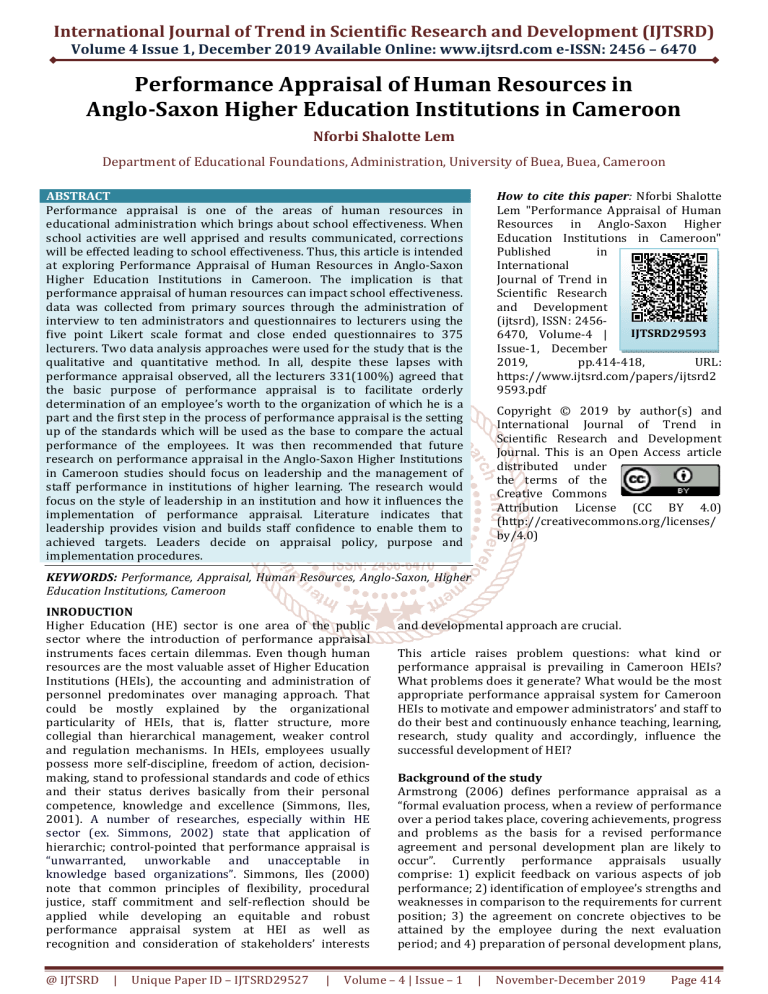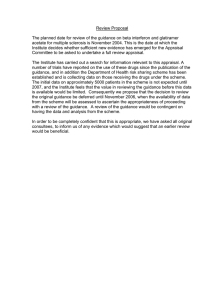
International Journal of Trend in Scientific Research and Development (IJTSRD)
Volume 4 Issue 1, December 2019 Available Online: www.ijtsrd.com e-ISSN: 2456 – 6470
Performance Appraisal off Human Resources in
Anglo-Saxon Higher Education Institutions in
n Cameroon
Nforbi Shalotte Lem
Department off Educational Foundations,
Foundations Administration, University of Buea, Buea,
Buea Cameroon
How to cite this paper:
paper Nforbi Shalotte
Lem "Performance Appraisal of Human
Resources in Anglo-Saxon
Anglo
Higher
Education Institutions in Cameroon"
Published
in
International
Journal of Trend in
Scientific Research
and Development
(ijtsrd), ISSN: 24562456
IJTSRD29593
6470, Volume-4
Volume
|
Issue-1,
1, December
Decemb
2019,
pp.414
pp.414-418,
URL:
https://www.ijtsrd.com/papers/ijtsrd2
9593.pdf
ABSTRACT
Performance appraisal is one of the areas of human resources in
educational administration which brings about school effectiveness. When
school activities are well apprised and results communicated, corrections
will be effected leading to school effectiveness. Thus, this article is intended
at exploring Performance Appraisal of Human Resources in Anglo-Saxon
Anglo
Higher Education Institutions in Cameroon. The implication is that
performance appraisal of human resources can impact school effectiveness.
data was collected from primary sources through the administration of
interview to ten administrators and questionnaires to lecturers using the
five point Likert scale format and close ended questionnaires to 375
lecturers. Two data analysis approaches were
wer used for the study that is the
qualitative and quantitative method. In all, despite these lapses with
performance appraisal observed, all the lecturers 331(100%) agreed that
the basic purpose of performance appraisal is to facilitate orderly
determination
n of an employee’s worth to the organization of which he is a
part and the first step in the process of performance appraisal is the setting
up of the standards which will be used as the base to compare the actual
performance of the employees. It was then recommended that future
research on performance appraisal in the Anglo-Saxon
Anglo
Higher Institutions
in Cameroon studies should focus on leadership and the management of
staff performance in institutions of higher learning. The research would
focus on the stylee of leadership in an institution and how it influences the
implementation of performance appraisal. Literature indicates that
leadership provides vision and builds staff confidence to enable them to
achieved targets. Leaders decide on appraisal policy, purpose
pu
and
implementation procedures.
Copyright © 2019 by author(s) and
International Journal of Trend in
Scientific Research and Development
Journal. This is an Open Access article
distributed under
the terms of the
Creative Commons
Attribution License (CC BY 4.0)
(http://creativecom
http://creativecommons.org/licenses/
by/4.0)
KEYWORDS: Performance, Appraisal, Human Resources, Anglo-Saxon,
Anglo
Higher
Education Institutions, Cameroon
INRODUCTION
Higher Education (HE) sector is one area of the public
sector where the introduction of performance appraisal
instruments faces certain dilemmas. Even though human
resources are the most valuable asset of Higher Education
Institutions (HEIs), the accountingg and administration of
personnel predominates over managing approach. That
could be mostly explained by the organizational
particularity of HEIs, that is, flatter structure, more
collegial than hierarchical management, weaker control
and regulation mechanisms.
isms. In HEIs, employees usually
possess more self-discipline,
discipline, freedom of action, decisiondecision
making, stand to professional standards and code of ethics
and their status derives basically from their personal
competence, knowledge and excellence (Simmons, Iles,
Iles
2001). A number of researches, especially within HE
sector (ex. Simmons, 2002) state that application of
hierarchic; control-pointed
pointed that performance appraisal is
“unwarranted, unworkable and unacceptable in
knowledge based organizations”. Simmons, Iles (2000)
note that common principles of flexibility, procedural
justice, staff commitment and self-reflection
reflection should be
applied while developing an equitable and robust
performance appraisal system at HEI as well as
recognition and consideration of stakeholders’
stakehold
interests
@ IJTSRD
|
Unique Paper ID – IJTSRD29527
29527
|
and developmental approach are crucial.
This article raises problem questions: what kind or
performance appraisal is prevailing in Cameroon HEIs?
What problems does it generate? What would be the most
appropriate performance appraisal system
sys
for Cameroon
HEIs to motivate and empower administrators’ and staff to
do their best and continuously enhance teaching, learning,
research, study quality and accordingly, influence the
successful development of HEI?
Background of the study
Armstrong (2006)
2006) defines performance appraisal as a
“formal evaluation process, when a review of performance
over a period takes place, covering achievements, progress
and problems as the basis for a revised performance
agreement and personal development plan are likely
lik
to
occur”. Currently performance appraisals usually
comprise: 1) explicit feedback on various aspects of job
performance; 2) identification of employee’s strengths and
weaknesses in comparison to the requirements for current
position; 3) the agreement on concrete objectives to be
attained by the employee during the next evaluation
period; and 4) preparation of personal development plans,
Volume – 4 | Issue – 1
|
November--December 2019
Page 414
International Journal of Trend in Scientific Research and Development (IJTSRD) @ www.ijtsrd.com eISSN: 2456-6470
a statement of each employee‘s career goals, decisions on
merit pays.
Also, according to Seta et al. (2000), initially performance
appraisals were quite brief, consisting mainly of a few
comments from a supervisor to his subordinate to the
extent that he or she was doing a “good job“ or, conversely,
a “bungle job”. However, afterwards performance
appraisals have become widely viewed not simply as a
means of informing employees on where do they stand,
but also as a valuable tool for helping them develop in
ways beneficial both themselves and the company.
Besides, Fisher et al. (2005) define the following principal
purposes
of
appraisal:
employee
development
(identification of training needs and preparation of
personal development plans), administrative decisions
(merit, pay, career, etc.), organizational development
(personnel
planning,
prevention
of
conflicts,
implementation of motivation system, etc.) and
documentation (conformity to official regulations,
certification of accordance to formal requirements, etc.).
Actually, the above mentioned purposes of performance
appraisal in practice usually overlap and thereinafter two
key opposite approaches are referred to. These are, as
Haslam et al (1993) define managerialist (aimed at
control, primarily concerned with assessment of
performance outcomes, and linked to promotion and merit
pay awards) and developmental (intended for the
purposes of staff development, explicitly stated and
backed up with adequate resources and effective
procedures designed to ensure that identified training
needs are met). The almost crucial step in developing a
performance appraisal system is to determine which
aspects of performance to evaluate. According to Fisher et
al. (2005) the most frequently used appraisal criteria are
traits, behaviors, and performance outcomes.
Türk (2008), stresses that performance appraisal has a
pivot role in reforming the educational system and
increasing productivity of academic staff, as well as raising
the overall quality of HEI. According to Allen (2003)
“performance appraisal is one of the most valuable
instruments in the manager’s toolbox. A careful appraisal
process can help improve an employee's performance for
an entire year. More broadly, an effective evaluation
process is part of the strategic first-rate people
management that helps organizations to succeed.”
Statement of the Problem
It is the governments concern to ensure that Higher
Institutions are accountable, relevance, efficient and
effective. The governments demand for accountability
implies that there is an expected return on investment. It
is expected that Higher Education Institutions should
achieve their missions of teaching, research and
community service efficiently to justify the high
investment. The academic staff performance is crucial for
the achievement of goals in higher learning institutions.
This implies that academic staff performance has to be
monitored to highlight factors that may lead to
ineffectiveness. The study therefore sought out to examine
performance appraisal of Human Resources in AngloSaxon Higher Institutions in Cameroon
@ IJTSRD
|
Unique Paper ID – IJTSRD29527
|
Research Questions
1. To find out the purpose and underlying principles of
performance appraisal of Human Resources in AngloSaxon Higher Institutions in Cameroon?
2. To examine the policies, plans and procedures in the
implementation of performance appraisal of Human
Resources in Anglo-Saxon Higher Institutions in
Cameroon?
3. To find out recommendations that can be made to the
existing performance appraisal systems of Human
Resources used in Anglo-Saxon Higher Institutions in
Cameroon to make the system a suitable mechanism
for institutional efficiency?
Research Questions
1. What are the purposes and underlying principles of
performance appraisal of Human Resources in AngloSaxon Higher Institutions in Cameroon?
2.
3.
What are the policies, plans and procedures in the
implementation of performance appraisal of Human
Resources in Anglo-Saxon Higher Institutions in
Cameroon?
What recommendations can be made to the existing
appraisal system of Human Resources used in AngloSaxon Higher Institutions in Cameroon to make the
system a suitable mechanism for institutional
efficiency?
Methodology
Since the study sought out to examine performance
appraisal of Human Resources in Anglo-Saxon Higher
Institutions in Cameroon, a survey research design was
employ. To estimate the sample size for lectures, the
formula stated below by (Amin, 2005) was used.
ܼܰ ଶ ܲ(1 − ܲ)
݀ ଶ (ܰ − 1) + ܼ ଶ ܲ(1 − ܲ)
Where:
N= Total number respondents that constituted the
accessible population of the study.
Z= Z value corresponding to the confidence level=95%,
giving a Zα/2 =level of significance = 1.96.
d= absolute precision=5%.
P= expected proportion in the population was 40% for
optimal sample size.
Thus, 231 out of a total of 375 lecturers were targeted
from University of Buea and 144 from the University of
Bamenda making a total of 375 lecturers. Lastly, for
administrators, it was 5 each from both institutions
making a total of 10 administrators’. A questionnaire was
used for lecturers and an interview guide for
administrators. Two data analysis approaches were used
for the study that is the qualitative and quantitative
method. Data collected via interview guide were analysed
qualitatively. Here, key concepts/themes, groundings and
quotations were used. These refer to the key words that
emerged from participants’ direct statements. On the
other hand, groundings represent the number of times
that a particular concept or theme emerged from the
participant’s direct statements with some of the
statements used as sampled quotations. The
questionnaires were analysed quantitatively. Through
this, a pre-designed EpiData Version 3.1 (EpiData
Volume – 4 | Issue – 1
|
November-December 2019
Page 415
International Journal of Trend in Scientific Research and Development (IJTSRD) @ www.ijtsrd.com eISSN: 2456-6470
Association, Odense Denmark, 2008) database which has
an in-built consistency and validation checks was used to
enter. Before the quantitative data were entered using the
pre-designed EpiData Version 3.1, the demographic
information and the test items were coded with numbers.
The questionnaires of individual respondents were also
assigned with serial numbers. The reason for the coding of
the test items was to ensure easy traceability of the
participants’ individual responses per test items if need
arises. The data were then exported to SPSS version 21.0
(IBM Inc., 2012) for further consistency check, data
validation, to identify invalid codes and eventually
cleaning of the data in areas where some inconsistency
and invalid codes were observed.
After the data had been thoroughly check, the descriptive
statistical tools (frequency count, percentages and
multiple responses set) and inferential statistics
(Spearman’s Rho test) were used in analyzing the
quantitative data. The normality assumption test was
computed using advanced statistical tests such as ShapiroWilk test and the Komogorov test of significance as seen
on the table of test of normality below. To know if a data is
normally distributed the P-value will be greater than 0.05
which was not the case as seen on the normality test table
with all P-values less than 0.05. This therefore justify the
reason while the Spearman rho test was used in testing
the hypotheses of the study. Checking for normality
assumption was very important to avoid faulty
generalization like committing the type 1 or type 2 errors
during the verification of the research hypotheses. Finally,
findings were presented using frequency distribution
tables, and charts with all inferential statistics presented
at 95% level of confidence interval with alpha set at 0.05
levels accepting 5% margin of error.
Presentation of Findings
This section was principally concerned with the
presentation of findings from 331 lecturers and 10
administrators.
To what extent does performance appraisal affect students’ internal efficiency in Anglo-Saxon Universities in
Cameroon?
Table1: Lecturers’ appreciation of performance appraisal
Stretched
Collapsed
Test items
Strongly
Strongly
Agree
Disagree
Agree
Disagree
agree
disagree
Performance appraisal is often done in my
137
72
122
0
209
122
department.
(41.4%)
(21.8%)
(36.9%)
(0.0%)
(63.1%)
(36.9%)
The basic purpose of performance
appraisal is to facilitate orderly
155
176
0
0
331
0
determination of an employee’s worth to
(46.8%)
(53.2%)
(0.0%)
(0.0%)
(100%)
(0.0%)
the organization of which he is a part.
Performance appraisal has been
discredited because often it has been used
229
102
0
0
331
0
as a top-down and mainly bureaucratic
(69.2%)
(30.8%)
(0.0%)
(0.0%)
(100%)
(0.0%)
system.
Performance Appraisal in universities
141
190
0
0
331
0
needs to appraise the performance of
(42.6%)
(57.4%)
(0.0%)
(0.0%)
(100%)
(0.0%)
everyone.
In my department, teaching and learning
141
75
56
59
216
115
is evaluated regularly.
(42.6%)
(22.7%)
(16.9%)
(17.8%)
(65.3%)
(34.7%)
After performance appraisal, the results
166
92
73
0
258
73
are communicated and discussed with the
(50.2%)
(27.8%)
(22.1%)
(0.0%)
(77.9%)
(22.1%)
employees on a one-to-one basis.
Performance evaluations typically look at
the achievements of members of staff but
162
162
7
0
324
7
the type of activities that are taken into
(48.9%)
(48.9%)
(2.1%)
(0.0%)
(97.9%)
(2.1%)
consideration vary between institutions
and countries.
The first step in the process of
performance appraisal is the setting up of
233
98
0
0
331
0
the standards which will be used as the
(70.4%)
(29.6%)
(0.0%)
(0.0%)
(100%)
(0.0%)
base to compare the actual performance of
the employees.
1145
865
477
161
2010
638
Multiple response set
(43.2%) (32.7%) (18.1%)
(6.1%)
(75.9%)
(24.1%)
n=331
In aggregate, findings showed that although 75.9% of the lecturers agreed that performance appraisal is done in their
institution and they equally positively appreciated it, 24.1% of the lecturers did not. For instance, all the lecturers
331(100%) agreed that performance appraisal has been discredited because often it has been used as a top-down and
mainly bureaucratic system. Also, although 209(63.1%) of the lecturers agreed that performance appraisal is done in their
department, 122(36.9%) of the lecturers disagreed. Also, although 258(77.9%) of the lecturers agreed that after
performance appraisal, the results are communicated and discussed with the employees on a one-to-one basis,
@ IJTSRD
|
Unique Paper ID – IJTSRD29527
|
Volume – 4 | Issue – 1
|
November-December 2019
Page 416
International Journal of Trend in Scientific Research and Development (IJTSRD) @ www.ijtsrd.com eISSN: 2456-6470
73(22.1%) of the lecturers disagreed with 115(34.7%) of the lecturers equally
equally disagreed that teaching and learning in
their department is regularly evaluated.
Despite these lapses with performance appraisal observed, all the lecturers 331(100%) agreed that the basic purpose of
performance appraisal is to facilitate orderly determination of an employee’s worth to the organization of which he is a
part and the first step in the process of performance appraisal is the setting up of the standards which will be used as the
base to compare the actual performance of the employees.
Figure1: Lecturers’ satisfaction with performance appraisal
Percentage
I am adequately satisfied with the way
performance appraisal is being done in my
department.
66.8
100
33.2
50
0
Agree
Disagree
Findings from figure 1 showed that among the 331 lecturers sampled 110(33.2%) of them were dissatisfied with
performance appraisal, meanwhile 221(66.8%) of the lecturers
lect
were satisfied.
Administrators’ own perception of performance appraisal
First, all the administrators interviewed said “performance
“performance appraisal of staff is conducted” whereby some of them said
“twice a year” while others said “in
in each semester”.
semester
Table2:
le2: The various ways the competencies of lecturers are evaluated
Themes
Frequency
Quotations
“Through students’ performance in their course
Students’ performance
7
examinations”. “Students performance”.
Effective use of time
1
“How the lecturers use their time”
Collaboration with other staff
1
“How they collaborate with other staff”.
From the table above, findings showed that students’
performance, lecturers’ effective use of time and their
collaboration with other staff were the only three ways
that the competencies of lecturers are evaluated as
depicted in the findings of this study.
Recommendations on policy and purpose of
performance appraisal
The recommendations were discussed as follows based on
the responses of participants in the research.
Staff is aware of the two essential roles of
performance
management
(judgment
and
development), but favour appraisal that places
emphasis on development, since it empowers them
with skills and competencies to achieve institutional
activities. Therefore, an appraisal policy has to
emphasise staff development, not only in the plans but
also during its implementation.
The performance appraisal policy should indicate
what is to be evaluated, the criteria and the methods
to be used in the assessment of performance.
performa
Performance appraisal system should be open,
continuous, participative and developmental. It should
emphasise research and adopt labour practices.
Also, considering how performance appraisal is important,
findings showed that some of the administrators said, it
helps them to check whether they are meeting up to
standard, to correct the weaknesses of workers, to equally
know the success rate of lecturers
turers and checking for the
attainment of goals of the institutions.
Also, based on the demerit with performance appraisal,
“favouritism”” was the only demerit highlighted by the
administrators interviewed for the study.
Lastly, as far as difficult aspects of performance appraisal
were concerned, findings showed that measuring the
actual performance of staff and setting realistic
performance standards were the two difficult aspects
captured in the findings of this study.
Recommendations
The following recommendations are based on the research
questions:
@ IJTSRD
|
Unique Paper ID – IJTSRD29527
29527
|
Recommendations on procedure of performance
appraisal
The following recommendations are made on the basis of
findings with regard to the procedure of performance
appraisal.
Volume – 4 | Issue – 1
|
November--December 2019
Page 417
International Journal of Trend in Scientific Research and Development (IJTSRD) @ www.ijtsrd.com eISSN: 2456-6470
Policies, procedure and measures used for collecting
evidence on performance should clearly be stipulated.
Job descriptions should be reviewed and aligned with
the institutional mission and goals.
Subordinates should set standards and indicators of
performance with their supervisors. Agreed goals will
ease the process of appraisal and the final rating.
The appraiser and appraisee should hold preliminary
meetings before the formal appraisal meeting to agree
on documents that should be available during the
meeting and set dates for the meeting.
Provide prompt feedback and written communication
on the results of appraisal.
Performance-related pay should be implemented due
to its motivational effects on staff performance.
However, other forms of motivation like praise and
acknowledgement for good performance are also
important.
Appraisers/supervisors are to be consistent in their
ratings to motivate staff, as one of the purposes of
appraisal is to motivate staff to perform.
Grievance procedure should
communicated to all staff.
be
written
and
Recommendations for future research in performance
appraisal
It was then recommended that future research on
performance appraisal in the Anglo-Saxon Higher
Institutions in Cameroon studies should focus on
leadership and the management of staff performance in
institutions of higher learning. The research would focus
on the style of leadership in an institution and how it
influences the implementation of performance appraisal.
Literature indicates that leadership provides vision and
builds staff confidence to enable them to achieved targets.
Leaders decide on appraisal policy, purpose and
implementation procedures.
@ IJTSRD
|
Unique Paper ID – IJTSRD29527
|
Conclusion
On the whole, Anglo-Saxon Universities approved of the
need for effective and efficient performance appraisal of
human resources in their institutions. It can therefore be
concluded that performance appraisal has a great role to
play as school management is concern to bring about
educational effectiveness in Anglo-Saxon Universities in
Cameroon. So good performance procedures should be
instituted and results communicated to the subordinates
or appraisees so that Universities can easily attain their
goals.
References
[1] Allen, P.L. (2003), Performance Appraisals with More
Harvard
Management
Gain,
Less
Pain.
Communication Letter, Vol. 6, No. 3.
[2] Armstrong, M. A handbook of human resource
management practice, 10th ed. London: Kogan page,
2006.
[3] Fisher, C., Schoenfeldt, L. and Shaw, J. (2005). Human
Resource Management, 6th ed. Boston: SouthWestern College. ISBN 978-0618527861.
[4] Seta, C. E., Paulus, P. B. and Baron, R. A. (2000).
Effective human relations: a guide to people at work.
4th ed. Pearson Education.
[5] Simmons, J. (2002). An expert witness perspective on
performance appraisal in universities and colleges.
Employee relations, Vol. 24, No. 1, pp. 86-100. MCB
University Press.
[6] Simmons, J. A., Iles, P. (2001). Performance appraisal
in knowledge based organisations: implications for
management education, International Journal for
Management Education, 2, 1, pp. 3-18. ISSN 14728117.
[7] Türk, K. (2008). Performance appraisal and the
compensation of academic staff in the University of
Tartu. Baltic Journal of Management, Vol. 3, No. 1, pp.
40-54. Emerald Group Publishing.
Volume – 4 | Issue – 1
|
November-December 2019
Page 418



